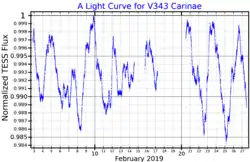| Observation data Epoch J2000 Equinox J2000 | |
|---|---|
| Constellation | Carina |
| Right ascension | 08h 40m 37.02758s[2] |
| Declination | −59° 45′ 39.6067″[2] |
| Apparent magnitude (V) | 4.31[3] |
| Characteristics | |
| Spectral type | B1.5III[4] |
| B−V color index | −0.117±0.005[3] |
| Variable type | Constant[5] |
| Astrometry | |
| Radial velocity (Rv) | +12.9±0.7[3] km/s |
| Proper motion (μ) | RA: −6.63[2] mas/yr Dec.: +5.32[2] mas/yr |
| Parallax (π) | 2.26 ± 0.11 mas[2] |
| Distance | 1,440 ± 70 ly (440 ± 20 pc) |
| Absolute magnitude (MV) | −3.91[3] |
| Details | |
| Mass | 12.5±0.6[6] M☉ |
| Luminosity | 6,322.92[3] L☉ |
| Temperature | 27,600±3,630[7] K |
| Age | 15.7±0.1[6] Myr |
| Other designations | |
| Database references | |
| SIMBAD | data |
V343 Carinae is a blue-white star or star system in the southern constellation of Carina. It has the Bayer designation d Carinae, while V343 Carinae is a variable star designation. The star is visible to the naked eye with an apparent visual magnitude of 4.31.[3] The distance to this object is approximately 1,440 light years based on parallax. It is drifting further away with a radial velocity of +13 km/s.[3]
This star was originally thought to be a Beta Cephei variable and a suspected eclipsing binary[9] with an orbital period of 133.92 days. It is now considered as probably constant.[10][5] Measurements indicate that at most it is a microvariable star with an amplitude of 0.0041 in visual magnitude and a period of 0.42029 cycles per day.[11] Eggleton and Tokovinin (2008) catalogued this as a single star, albeit with some uncertainty.[12] However, Chini et al. (2012) listed it as a single-lined spectroscopic binary system.[13]
The visible component of V343 Carinae has a stellar classification of B1.5III,[4] matching a massive blue giant. It has 12.5[6] times the mass of the Sun and is an estimated 16[6] million years old. The star is radiating 6,323[3] times the Sun's luminosity from its photosphere at an effective temperature of 27,600 K.[7] It has a visual magnitude 13.3 companion at an angular separation of 16.4″ along a position angle of 339°, as of 2010.[14]
References
- ↑ "MAST: Barbara A. Mikulski Archive for Space Telescopes". Space Telescope Science Institute. Retrieved 8 December 2021.
- 1 2 3 4 5 van Leeuwen, F. (2007), "Validation of the new Hipparcos reduction", Astronomy and Astrophysics, 474 (2): 653–664, arXiv:0708.1752, Bibcode:2007A&A...474..653V, doi:10.1051/0004-6361:20078357, S2CID 18759600.
- 1 2 3 4 5 6 7 8 Anderson, E.; Francis, Ch. (2012), "XHIP: An extended hipparcos compilation", Astronomy Letters, 38 (5): 331, arXiv:1108.4971, Bibcode:2012AstL...38..331A, doi:10.1134/S1063773712050015, S2CID 119257644.
- 1 2 Houk, Nancy; Cowley, A. P. (1979), Michigan catalogue of two-dimensional spectral types for the HD stars, vol. 1, Ann Arbor, Michigan: Dept. of Astronomy, University of Michigan, Bibcode:1978mcts.book.....H.
- 1 2 Samus, N. N.; et al. (2017), "General Catalogue of Variable Stars", Astronomy Reports, 5.1, 61 (1): 80–88, Bibcode:2017ARep...61...80S, doi:10.1134/S1063772917010085, S2CID 125853869.
- 1 2 3 4 Tetzlaff, N.; et al. (January 2011), "A catalogue of young runaway Hipparcos stars within 3 kpc from the Sun", Monthly Notices of the Royal Astronomical Society, 410 (1): 190–200, arXiv:1007.4883, Bibcode:2011MNRAS.410..190T, doi:10.1111/j.1365-2966.2010.17434.x, S2CID 118629873.
- 1 2 Sokolov, N. A. (May 1995), "The determination of Teff of B, A and F main sequence stars from the continuum between 3200 A and 3600 A.", Astronomy and Astrophysics Supplement, 110: 553, Bibcode:1995A&AS..110..553S.
- ↑ "d Car". SIMBAD. Centre de données astronomiques de Strasbourg. Retrieved 19 March 2016.
- ↑ van Hoof, A. (June 1973), "Six New Variable B-Stars", Information Bulletin on Variable Stars, 807: 1, Bibcode:1973IBVS..807....1V.
- ↑ Waelkens, C.; Rufener, F. (May 1983), "An observational study of the influence of close companions on the pulsations of beta Cephei stars", Astronomy and Astrophysics, 121: 45–50, Bibcode:1983A&A...121...45W.
- ↑ Koen, Chris; Eyer, Laurent (March 2002), "New periodic variables from the Hipparcos epoch photometry", Monthly Notices of the Royal Astronomical Society, 331 (1): 45–59, arXiv:astro-ph/0112194, Bibcode:2002MNRAS.331...45K, doi:10.1046/j.1365-8711.2002.05150.x, S2CID 10505995.
- ↑ Eggleton, P. P.; Tokovinin, A. A. (September 2008), "A catalogue of multiplicity among bright stellar systems", Monthly Notices of the Royal Astronomical Society, 389 (2): 869–879, arXiv:0806.2878, Bibcode:2008MNRAS.389..869E, doi:10.1111/j.1365-2966.2008.13596.x, S2CID 14878976.
- ↑ Chini, R.; et al. (2012), "A spectroscopic survey on the multiplicity of high-mass stars", Monthly Notices of the Royal Astronomical Society, 424 (3): 1925, arXiv:1205.5238, Bibcode:2012MNRAS.424.1925C, doi:10.1111/j.1365-2966.2012.21317.x, S2CID 119120749.
- ↑ Mason, B. D.; et al. (2014), "The Washington Visual Double Star Catalog", The Astronomical Journal, 122 (6): 3466, Bibcode:2001AJ....122.3466M, doi:10.1086/323920.
